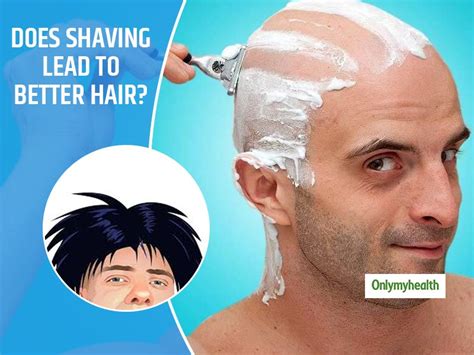Introduction
Understanding Balding
Balding, medically termed androgenetic alopecia, is a common hair loss condition that primarily affects men. It occurs due to a genetic sensitivity to a hormone called dihydrotestosterone (DHT). DHT binds to hair follicles, causing them to shrink and eventually stop producing hair.

Debunking the Myth: Shaving Does Not Prevent or Fight Balding
Despite popular belief, shaving your hair does not prevent or fight balding. Shaving only removes the visible hair shaft and does not impact the hair follicles beneath the skin. The process of balding occurs within the hair follicle, where DHT exerts its effects. Shaving does not interfere with this process.
Supporting Research
Numerous scientific studies have debunked the myth that shaving hair fights balding. For instance:
-
A 2014 study published in the Journal of the American Academy of Dermatology found no evidence to support the claim that shaving hair affects hair loss or growth.
-
A 2018 study published in the International Journal of Dermatology concluded that shaving does not influence hair follicle activity or hair growth.
Causes of Balding
Balding is primarily caused by genetic factors and hormonal changes related to aging. Other potential causes include:
- Medical conditions (e.g., alopecia areata, thyroid issues)
- Medications (e.g., chemotherapy drugs)
- Male-pattern baldness
- Stress
- Poor nutrition
- Certain hair treatments (e.g., chemical relaxers)
Effective Strategies for Combating Balding
Although shaving does not prevent or fight balding, there are effective strategies available:
- Minoxidil: A topical medication that stimulates hair growth.
- Finasteride: A prescription drug that blocks DHT production.
- Platelet-rich plasma (PRP) injections: A therapy that uses injections of concentrated platelets to promote hair growth.
- Hair transplantation: A surgical procedure that involves transplanting hair follicles from a donor area to the balding areas.
Common Mistakes to Avoid
- Ignoring the underlying cause: It is essential to identify and address the underlying cause of hair loss before seeking treatment.
- Using ineffective treatments: Not all hair loss treatments are equally effective. Consult with a healthcare professional to determine the best course of action.
- Delaying treatment: Hair loss can прогресс over time. Seeking treatment sooner increases the chances of successful results.
- Discontinuing treatment prematurely: Many hair loss treatments require consistent use over several months to be effective. Discontinuing treatment too early may hinder results.
Frequently Asked Questions (FAQs)
1. Can a buzz cut make my hair come back thicker?
Shaving or cutting hair does not affect hair thickness. Hair thickness is determined by genetics and cannot be influenced by shaving.
2. Will shaving my head help my hair grow faster?
Shaving does not impact hair growth rate. Hair grows at a predetermined rate dictated by genetics and individual factors.
3. Does shaving my head affect my hair follicles?
Shaving removes the visible part of the hair, not the hair follicles. Shaving does not damage or alter hair follicles.
4. Is balding curable?
While there is no complete cure for balding, there are effective treatments that can slow down hair loss, promote hair growth, and improve hair appearance.
5. What are the signs of impending balding?
Common signs of impending balding include:
– Thinning hair
– Receding hairline
– Circular or diffused patches of hair loss
6. Is balding reversible?
Once hair follicles are lost, they cannot be replaced. However, treatments such as minoxidil and finasteride can help maintain or restore existing hair, slowing down the progression of balding.
Conclusion
Shaving your hair does not prevent or fight balding. While it is a quick and easy way to remove unwanted hair, it does not address the underlying cause of hair loss. Effective strategies for combating balding involve addressing the underlying cause and adopting evidence-based treatments recommended by healthcare professionals. Understanding the facts and avoiding common mistakes is crucial for successfully managing hair loss and maintaining healthy hair.
